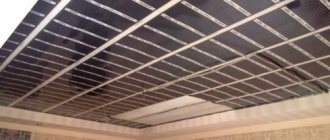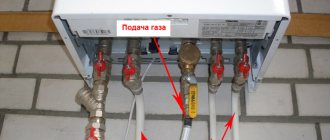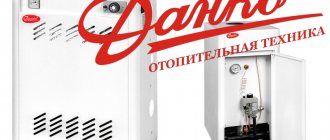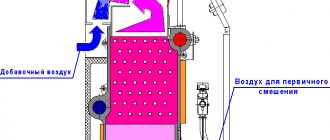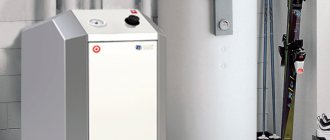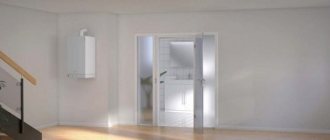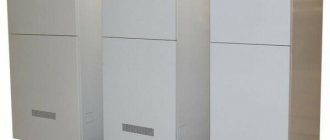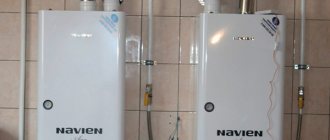Here you will learn:
- What is PLEN
- Positive and negative consumer reviews
In this review we look at reviews from real owners about PLEN. Film infrared heating allows you to heat households with minimal energy costs. But since it is an innovation, consumers need ratings from existing users. Let's see what people are saying about this new product. Along with the reviews, the review will give the identified advantages and disadvantages.
What is the PLEN heating system?
PLEN is a heating system that is based on the use of an electric film heater, the individual design of which produces infrared radiation.
The laminated coating 100% prevents liquid penetration onto the heating resistor.
A film heater can be ceiling-mounted, or installed on a wall or floor, and then masked with a decorative coating (tile, plasterboard, plastic, MDF).
The system operates from a 220 V power supply and can withstand voltage surges from 160 V to 300 V.
The PLEN design is used:
- for heating dachas, cottages;
- for heating premises for production, warehouses, garages;
- for heating retail and administrative areas;
- for heating restaurants, cafes and bars;
- for heating apartments;
- for heating greenhouses;
- for drying wood;
- for drying in car paint shops;
- for a healing small sauna.
What types of IR heaters are there?
The modern market offers so many varieties of products that it is easy to get confused in this abundance.
Let's divide all types of heaters into categories. According to the type of installation, infrared heaters can be divided into the following: ceiling; floor; wall-mounted Ceiling heaters are considered the most effective in terms of heating the room. Their radiation covers almost the entire area of the room. Such heating is safe, harmless, and comfortable. Some models are installed at the junction between the ceiling and the wall.
Floor heaters are not as efficient as ceiling heaters. However, their advantage is ease of use (they do not require special installation, they are plugged into an outlet). It is recommended to buy such devices to replace oil heaters, since they are much more comfortable and economical.
Wall-mounted IR heaters are used outdoors. This is a separate class of IR heaters - convective-infrared heaters. This is a type of device that not only emits IR heat, but also warms up the air next to it. In this they are similar to Soviet cast iron batteries.
Types of heaters by wavelength
According to the wavelength, IR heaters can be: short-wave;
medium wave; long-wave. Shortwave heaters. They have a high heating temperature (up to 800 degrees Celsius) and glow red. Short-wave heaters are halogen, quartz, carbon.
As a rule, they are mounted on the wall or installed on the floor. It is very comfortable to be under the rays of such a device for a long time, since the temperature is high. As a rule, shortwave models are installed outdoors.
Medium wave devices. They are also not recommended for heating residential premises. These are models of heaters with an open heating element. Medium wave heaters consist of a steel tube heated to a red glow, surrounded by a reflector. Application: rooms with high ceilings (workshops, warehouses), rooms exposed to drafts (subway).
Long wave heaters. They emit a fairly gentle flow of heat. It is this variety that is recommended for use for basic or additional heating of residential premises, as well as children's and medical institutions. The heat from long-wave devices is felt much less, but it is much more comfortable and pleasant.
Design and principle of operation of a film electric heater
The film heater is characterized by a multilayer lavsan construction with a maximum thickness of 1.2 mm. Inside the lavsan films there are built-in special heating elements made of metal and aluminum foil, which can heat up to 45 °C.
Lavsan material is intended for the functions of electrical insulation and external finishing.
When the PLEN heating is connected, electricity moves to resistive elements that heat the foil. The IR rays that are produced as a result have a length of 9.4 microns and heat objects in the room, equipment, floors, and people. Therefore, a favorable microclimate is maintained in residential premises at all times.
Infrared heating PLEN can act both as the main source and as an additional one.
The flow of warm air from the IR film is distributed evenly throughout the room.
Instead of an afterword
What kind of heating to install in the house is a personal decision for everyone. However, PLEN is a truly innovative material that allows you to save a decent portion of your budget. For those who talk about the high cost and high energy consumption, we can only advise them to better insulate their home.
PLEN can be mounted even in the bathroom - it is not afraid of slight humidity
We hope that the information presented today was useful to our dear reader. We will be happy to answer your questions in the discussion if they arise while reading the article. Write, ask and share your experience - because it can help someone.
Advantages and disadvantages
How does the PLEN heating system work?
A film electric heater, in addition to saving energy, has a number of other advantages:
- Easy and quick installation. To start the film heater, you do not need to install additional communications, you only need an electrical network. Installation of a turnkey system for an area of 100 m² will take about two days.
- If the need arises, the heating system can be dismantled without damaging its functionality.
- The operational period of the PLEN IR system is at least 50 years.
- Voltage drops and instability of the power supply are not scary.
- PLEN heating is fireproof.
- It is stable and can only become unusable along with the premises.
- Creation of a favorable microclimate.
- Heating the air in a room from 10 to 20 °C will occur in just 40–50 minutes (while convective air heating from 10 to 20 °C will require more than 10 hours).
- Since the system is self-regulating, it will independently maintain the specified heating temperature stable by automatically turning the heaters on and off (a thermostat is installed).
- The PLEN system can operate from the power supply all year round.
- When heating using this method, oxygen is not burned and the air does not dry out.
- No dust (since the principle of convection is not applied).
- Infrared rays do not have a negative effect on human health.
- When installing the PLEN system in rooms in areas with a humid climate, humidity indicators will be normal due to effective drying.
- When the device operates, there are completely no combustion products.
- The operation of the system without noise ensures its installation in country houses, cottages, recreation centers, pavilions, etc.
- Aesthetics. PLEN heating can be covered with various decorative materials that do not contain metal.
- Fast payback. This heating system pays for itself to the owner within 2-3 years.
What types of thermostats are there?
There are many advantages of using the heating system in question. However, it also has disadvantages:
- It is worth saying that a film IR heater on the ceiling is not very effective. Warm air accumulates near the ceiling and it seems as if only the upper body and head are warming up, while the legs remain cold.
- With high heat transfer, the PLEN heating system only works in rooms with good thermal insulation.
- The surface on which the system is installed must be hard, level and dry.
- The IR design should be treated with care; it cannot withstand various mechanical impacts.
- Using the PLEN system as the main source of heating in very cold rooms can lead to significant energy costs.
You can read more about infrared electric heaters here.
Advantages
This heater has a number of advantages:
- It allows you to create a heating scheme for rooms by zones or covering the entire space.
- Has a low price.
- Makes it possible to save up to 40% energy compared to other heating systems.
- An infrared film heater located on the ceiling does not take up any useful space.
- It practically does not reduce the height of the ceilings.
- It features quiet operation and high efficiency, and also heats up instantly.
Experts believe that an IR film heater is the most effective way today to efficiently heat any room for its intended purpose.
Specifications
Having considered the advantages and disadvantages, everyone has the right to make a personal choice in favor of heating with a film electric heater. To be sure to compare it with other types, we present the main technical characteristics. We suggest viewing several useful tables.
Technical characteristics of the PLEN heating system.
| Characteristics | Meaning |
| Supply voltage | 220 V |
| Power | 120-160 W/m² |
| Maximum power | 160 W/m² |
| Rated power | 20-40 W/m² |
| Wavelength | 6-20 microns |
| Heating element operating temperature | 40-45 °C |
| Dimensions | Made to order |
| Weight | 0.9 kg/m² |
| Protection by class | IP 44 |
| Width of PLEN strip | 200, 300, 400 and 600 mm |
| Warranty period | 3 years |
| Life time | more than 50 years |
| Infrared radiation | At least 90% |
| Heating element film thickness | 0.3 mm |
Calculation of the PLEN heating system for various premises.
| Heated area, m² | Average monthly electricity consumption, kW/h | Approximate cost of a heating system kit, rub. |
| 8 | 58 | 9 200 |
| 12 | 87 | 13 380 |
| 18 | 130 | 20 070 |
| 36 | 260 | 40 140 |
| 90 | 648 | 98 280 |
For compact rooms or rooms with complex geometric configurations, systems with a voltage of 110 V are available.
Price
If there is a question about a heating system from scratch, then you can focus on comparative tables for the Moscow region:
| Costs for a house of 150 square meters, rubles | Gas | Diesel | Solid fuel boiler | PLEN |
| Design work | 40000 | 40000 | 40000 | – |
| Installation | 120000 | 120000 | 120000 | 120000 |
| Commissioning | 40000 | 40000 | 40000 | 40000 |
| Equipment price | 360000 | 320000 | 300000 | 340000 |
| Total | 560000 | 520000 | 500000 | 500000 |
| Operating costs, rubles | Gas | Diesel | Solid fuel boiler | PLEN |
| Gas consumed, purchase of pellets, diesel fuel per month | 1600 | 2400 | 1600 | 1200 |
| Costs for the heating season (6 months) | 9600 | 14400 | 9600 | 7200 |
| Repair and maintenance costs per season | 1600 | 1600 | 1600 | – |
| Total for 1 year of operation | 13200 | 16400 | 13200 | 7200 |
| Total for 5 years of operation | 66000 | 82000 | 66000 | 36000 |
The cost of equipment increases if:
- The room area is large and a film of maximum size is required.
- There is additional protection from moisture and dust (sauna, greenhouse).
- Maximum sheet thickness required (increased power).
There is no point in looking for imported goods. This is a domestic development, so our quality is better.
These calculations confirm that the one-time costs of replacing a heating system are impressive, but the payback occurs in 2-3 years. Considering the durability and ease of use, the economic benefits are obvious.
Installation
Do-it-yourself installation of the PLEN system is characterized by simplicity and low time investment.
For convenience, the device is produced in different parameters. The length can vary from 1 to 5 meters, width - from 0.35 to 0.65 meters.
If you choose PLEN as the main heating system, then think about the level of air exchange. The higher the indicator, the greater the efficiency will be.
The PLEN system is installed on 80% of the ceiling surface and is perfect for plasterboard structures, suspended and suspended ceilings. After starting the system, the IR rays gradually begin to warm up the room, and after 13 days on average they are fully installed at the level of normal heat energy distribution.
If you decide to install the IR device yourself, then think carefully. Even minor errors can have a negative impact on safety, which costs more than the prices of the experts.
Installing a film electric heater on the ceiling
Installation instructions:
- Initially, you need to prepare working surfaces, which must be reliably insulated, leveled, and cleaned.
- Due to the dispersion of infrared radiation on the sides, it is necessary to direct it to the center of the room; for this, foil is glued to the surface under the PLEN, which is in contact with the surface of the walls, floor or ceiling with the foil part. The foil film can be replaced with penofol. In this case, fastening is carried out using a construction stapler with staples.
- Attach the PLEN strips with a special stapler.
- The foil sheet is overlapped by 2-3 centimeters and sealed with foil adhesive tape. Heating strips can be placed leaving a gap of up to 20 centimeters.
It is recommended to install the cable channel into which the wiring of infrared devices is planned to be installed directly next to the heating film. Remember to be careful: do not violate the integrity of the system.
Wiring laid in the cable channel must be connected parallel to the main line. The cross-section of the wire can be different and depends on the power parameters of the heating system.
Now it’s time to choose the optimal location for the thermostat. It is installed at a height of 1.7 meters from the floor in any chosen location. For the results to be fair, the surface above the device must be warm. In a small room, the thermostat can be connected to a break in the line so that you do not have to pull the power wire from the panel and start it using a magnetic contactor.
In order to complete all the work efficiently, it is recommended to start the heating system to be sure of its functionality.
Varieties
It is most convenient to classify infrared heating devices according to their installation location.
Ceiling
Infrared ceiling heating is the most common, since the ceiling at a height of up to 3 m is the optimal place to install an IR source.
Most ceiling models are of the lamp type.
Their emitters are made in the form of a cylinder or plate, and the device itself has an elongated shape and resembles a fluorescent lamp.
You can fix the “heating pad” on brackets, but the most popular type of fastening is a suspension in the form of a chain, the length of which can be independently adjusted.
In addition to a lamp heater, you can place a film IR heater on the ceiling. This truly revolutionary invention consists of two layers of polymer film, between which there are tracks of carbon paste. It plays the role of an IR emitter. The heater itself has the form of a thin sheet, which is laid on the ceiling and screwed with dowels or self-tapping screws.
Wall mounted
Devices in this series can not only heat a room, but also aesthetically enliven its interior.
They are made using film technology (infrared film for heating), with a colorful pattern applied to their outer layer.
Such picture heaters have become very popular recently.
Floor-standing
Special models of IR film, equipped with a self-adhesive base, are designed for laying on the floor. After installation, the finishing floor covering is laid on top of the heater.
Infrared heated floor
Those wishing to install a wall-mounted picture heater should take into account that the surface of the device heats up quite strongly.
If there are small children or animals in the house, the device should be installed so that they cannot touch it.
Tips for choosing a PLEN system
In order to make the right decision when choosing this infrared heating, it is worth taking note of some nuances. Otherwise, you risk not only “throwing money away”:
- The first thing you need to pay attention to is the thermal insulation of the living space (walls, floors, windows, ventilation systems), where it is planned to install the electric heater, and the thermal conductivity of the coating under the PLEN system. Otherwise, even in the calmest weather, heat energy losses will be significant.
- The second tip is to analyze the climate in which your home is located. The heat losses of the room, which is located in the zone of constant winds, are very high. This means that in order to create a favorable microclimate, the PLEN heating system must be turned on frequently, which in turn means that electricity costs will be significant.
If you follow these simple recommendations, you will make the right decision and choose a quality device, thereby providing yourself and your loved ones with a comfortable and cozy stay and reducing energy costs.
Installation of the PLEN heating system on the floor
Calculation of PLEN energy consumption using the example of a house of 100 square meters. m
Our homes lose the most heat through windows, doors, floors and roofs. By choosing the best building and finishing materials, you can save a lot on heating costs.
We have already calculated how much film is needed. But will heating really “eat up” so much electricity? In fact, the costs will be small. Firstly, PLEN heating does not work around the clock - it turns on and off, obeying the thermostat. And secondly, infrared heating is economical. Therefore, the costs will not be very high.
If the house has good thermal insulation, then PLEN will work for about 10-15 minutes per hour. Based on the average cost of 1 kW of energy at 4 rubles, the cost of round-the-clock operation for a house of 100 sq. m would be 960 rubles per day. If the heating runs for 10 minutes, the daily consumption will be only 160 rubles. This will cost approximately 4,800 rubles per month.
Heating the entire room
Efficient heating of an entire room is possible using low intensity infrared heating elements, but the heating system must be designed and installed well, and used accordingly. The most basic mistake during installation is that the user installs one large heater, which, according to its parameters, will be neither effective nor economical. One large heater creates an intense heating zone and has the unintended consequence of cold air flowing from other parts of the building, thereby causing the objects under the infrared heater to become intensely warm, but the person can feel the cold air from below. A more efficient design practice is to design a balanced system that can use two or more heaters located throughout the area to provide comfortable heat within the room.
Advantages and disadvantages, benefits and harms of infrared heating for the home
Let's look at the pros and cons of infrared heating, both from the point of view of obtaining a comfortable and profitable heat supply, and the impact on the human body.
Considering that such heating does not burn oxygen, its use allows maintaining the required air humidity. With the correct location of the system with the appropriate selection of equipment models, it is possible to achieve both spot heating and the required temperature conditions in areas of residence or work. This is confirmed by those who have already installed infrared heating in a private home, whose reviews help make the right choice.
Pros of IR heating
For the home, the most effective types of heaters are ceiling and wall. They are very easy to install. However, heated floors with IR elements are often used, which are installed under all types of floor coverings. Considering the pros and cons of infrared heating, let us first note its advantages:
rapid heating of the room; high resistance to power surges, which is important for the private sector located outside large cities; does not dry out the air; ease of installation - no special skills or tools required; highly economical.
Cons of IR heating
Disadvantages of infrared heating:
- the difficulty of combining ceiling models with the interior style. They are least suitable for installation in rooms where a classic style is chosen;
- the need for preliminary design of such a heating system for proper heat distribution in the room.
Considering these disadvantages of infrared heating, you can count on obtaining the maximum economic and thermal effect at any time of the year.
Benefit or harm - the dilemma of installing infrared heating
Design of an infrared heating system
Many people wonder: is infrared heating dangerous for humans? After all, it is radiation, and this word in itself causes concern. Since infrared radiation is an integral part of sunlight, which is completely harmless if you follow the basic rules of exposure to it, heating of this type is safe if you follow the basic rules of use. In infrared heating itself, there are no chemical reactions harmful to health, and there are no rotating or rubbing elements that could become a source of vibration or noise. All these are signs of not only high environmental friendliness, but harmlessness to humans.
Infrared heating uses the wave ranges that are safest for human health, with a minimum amount of radiation power. However, it cannot be said that infrared heating cannot harm human health. The danger comes from non-compliance with the basic rules for using the equipment, as well as its incorrect placement. As a result of such violations, the following negative consequences may occur:
- overheating, in the presence of a heater several times higher than the power characteristics required for a given room;
- overdrying of the skin when a person’s position does not change for a long time, and a heater with high temperature settings affects only one side of the human body;
- Often the harm of infrared heating manifests itself when the ceiling option is mistakenly installed above the seating area in the area where the head is located. Heater exposure can cause severe headaches;
- Excessive radiation power can cause damage to cells in the human body.
Is infrared heating harmful? No, if the correct equipment parameters are selected and all technical requirements for installation and use are met.
Interesting on the topic:
- Specifics of heating a frame house made of SIP pa.
- DIY water heating installation
- Features of autonomous gas heating.
- Calculation of a solid fuel boiler, the most economical.
Comments on the article:
Sergey. 02/01/2017 at 18:02
what effect will the i/f film have on the wire? it will deteriorate and dry out over time

